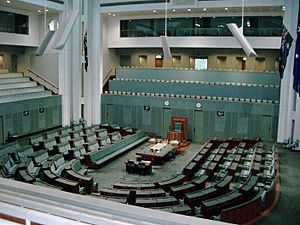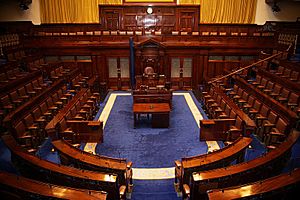Lower house facts for kids
Imagine a country's government like a big team that makes rules and laws. Many countries have a special group that makes these laws, called a legislature.
Sometimes, this law-making group is split into two parts, like two different rooms or "chambers." When this happens, it's called a bicameral legislature. One part is known as the lower house, and the other is the upper house.
Even though it's called the "lower" house, it often has more power and say in making laws than the "upper" house. It's a bit like being the main player on a sports team!
Contents
What Makes a Lower House Special?
Lower houses often have special features compared to upper houses. Let's look at some of them.
How Lower Houses Get Their Power
The power of a lower house can depend on the type of government a country has.
In a Parliamentary System
In a parliamentary system, the lower house usually has a lot more power.
- It can often overrule the upper house on many decisions.
- Members of the lower house can vote to show they no longer trust the government. This is called a motion of no confidence. If this vote passes, the government might have to resign.
- However, there are exceptions. In Australia, the Senate (upper house) has almost as much power as the House of Representatives (lower house). In Italy, both houses have the same powers.
In a Presidential System
In a presidential system, the lower house also has important powers.
- It often has the only power to start the process of removing a high-ranking official, like the president. This process is called impeachment. The upper house then decides if the official is guilty.
- Laws about money, like raising taxes or spending government funds, usually have to start in the lower house.
Other Key Features of a Lower House
Here are some other common things that make a lower house unique:
- Direct Elections: Members of the lower house are almost always chosen directly by the people through elections. Upper house members might be elected differently, or not at all.
- More Members: A lower house usually has more members than the upper house.
- Population Representation: Areas with more people usually have more representatives in the lower house. This means representation is often based on how many people live in an area.
- Frequent Elections: Members are often elected more often than those in the upper house.
- All at Once: All members are usually elected at the same time, not in groups over several years.
- Government Control: In a parliamentary system, the government can sometimes dissolve the lower house. This means calling for new elections before the usual time.
- Money Matters: The lower house often has the main say over the country's budget and money laws.
- Younger Candidates: You can usually run for a seat in the lower house at a younger age than for the upper house.
Examples of Lower Houses Around the World
Many countries have a lower house. Here are a few examples:
- France: the National Assembly
- Pakistan: the National Assembly
- United Kingdom: the House of Commons
- United States of America: the United States House of Representatives
- Australia: the Australian House of Representatives
Images for kids
See also
 In Spanish: Cámara Baja para niños
In Spanish: Cámara Baja para niños





